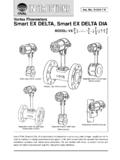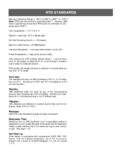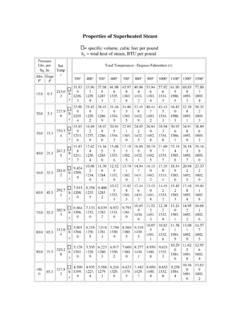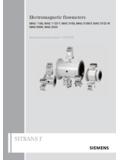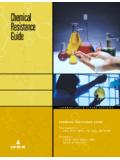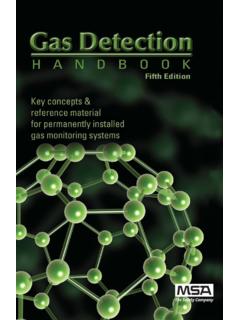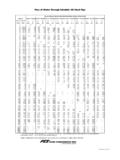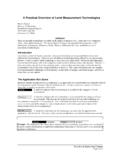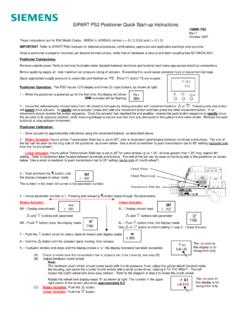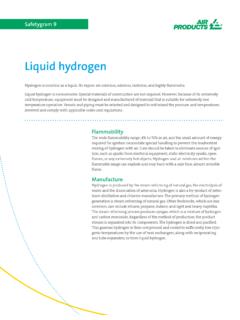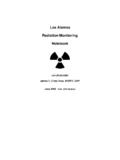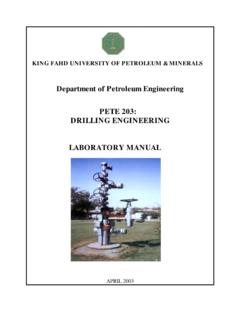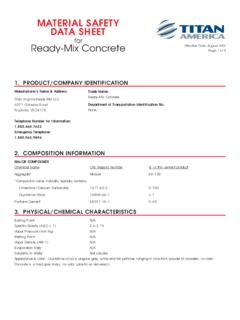Transcription of Flowmeters - Gilson Eng
1 Flowmeters DIFFERENTIAL PRESSURE - ORIFICE where V2. = kinematic energy 2g The most commonly used flowmeter is the orifice meter. The orifice meter consists of two parts. As shown in Fig- Lz = potential energy due to gravity ure 1, they are the measurement orifice plate, which is in- P = potential energy due to static stalled in the process line, and the differential pressure transmitter, which measures the pressure developed across = density of fluid the orifice plate. There has been extensive research to de- u = internal energy in the fluid termine the operating characteristics of orifice meters. q = change in heat energy of the fluid The physical phenomenon of the orifice meter is described ws = shaft work done by the fluid by the Continuity equation and the Bernoulli equation. The continuity states that the mass entering a control volume For virtually all flow applications, this equation can be sim- is the same as the mass leaving the control volume.
2 (Con- plified. The first simplification is to state that there is no trol volumes are convenient methods for studying fluid heat transfer in the control volume, so the factor q is problems). In a numerical form, the Continuity equation The next simplification is that there is no shaft work, so is written: ws is Reference - Flowmeters m1 = m2 ORIFICE EQUATION FOR LIQUIDS. A1V1/v1 = A2V2/v2. Since liquids are incompressible under normal operating To help make this point, imagine the flow of water through conditions, the equations governing orifices can be further a pipe. For this example, we will assume that the liquid is simplified for them. The first simplification is made in the incompressible, that is its volume (v) is constant. This is a continuity equation, specified volume, v, is constant and legitimate assumption because liquids are virtually incom- can be eliminated from the equation yielding: pressible at normally encountered pressures and tempera- tures.
3 If v is constant, the continuity equation simplifies V1A1 = V2A2 or V1 = A2V2 /A1. to: Bernoulli's equation can be simplified for liquids if these A1V1 = A2V2 conditions are assumed; the pipe is horizontal and the in- ternal energy is the same in the sections on temperature If the liquid flows through an orifice, the area of the pipe and fluid properties ( the temperature is the same). Based will be reduced in the orifice and the velocity will increase on these assumptions, Bernoulli's equation becomes: as the fluid passes through the orifice. P1 + V12 = P2 + V22. The Bernoulli equation relates the increase in velocity to a change in static pressure. In more general terms, Bernoulli's 2g 2g equation relates the energy at one point in the control vol- If we substitute V1 from the continuity equation, we can ume to the energy in a second point in the control volume.
4 Rewrite Bernoulli's equation as: Bernoulli's equation written on a per unit weight basis can be represented as: V22 [1-(A2 /A1)2] = 1(P1 - P2). 2g . V12 + Lz1 + P1 + u1 =. 2g or V22 + Lz2 + P2 + u2 + q + ws V22 = 1 [2g(P1 - P2)]. 2. 2g [1 - (A2 /A1) ]. These are the basic orifice equations. Since it is common Differential Pressure Differential Pressure to use these measure volumetric flow or mass flow, the Transmitter Transmitter square root is usually taken on both sides of the equation to solve for V2. Impulse Lines Impulse Lines ( )1/2V2 = 1 [2g(P1 - P2)]1/2. Orifice Flange with Flange Taps Orifice Flange with Flange Taps [1 - (A2 /A1)2]1/2. Flow Flow Orifice Plate Orifice P;ate FIGURE 1 Orifice Plate and Differential Pressure Transmitter Americas +1 215 646 7400 ext. 6613 Asia Pacific +65 299 6051 Europe +44 1935 706262 305.
5 Since Q is equal to A2V2, we multiply both sides of the ORIFICE EQUATIONS FOR GASES AND. equation by A2 and divide both sides by ( )1/2 yielding: STEAM. Q = A2V2 = A2 [2g(P1 - P2)]1/2. To use the orifice equations for gases and steam, an addi- [1 - (A2 /A1)2]1/2 ( )1/2 tional factor must be added to compensate for the fact Also, since the mass flow rate W, is equal to the volumet- that gases and steam are compressible. The factor is called ric flowrate times the density, W can be expressed as: the expansion factor and denoted by Y. The expansion factor is determined by taking the ratio of actual flow of a W = Q = A2 [2g (P1 - P2)]1/2. gas or steam through an orifice to the flow that is predi- [1 - (A2 /A1)2]1/2 cated by the liquid orifice equation. The expansion factor The term 1/[1 - (A2 /A1)2]1/2 is called the Velocity of Ap- can then be added to the liquid equation to make it suit- proach factor.
6 Contained within this term is the Beta Ra- able for gases and steam. The equation then becomes: tio. The Beta Ratio is the ration of the area of the orifice to Qact = YKA2 [2g(P1 - P2)]1/2. the area of the pipe, A2A1. The Beta Ratio is typically de- ( )1/2. picted by the Greek letter . The velocity of approach factor can sometimes be com- bined with other coefficients. These equations are the theo- A, ME, AND OTHER MONATOMIC GASES. retical flow equations and are based on the fluid area at the downstream pressure tap. The area of the fluid is not Reference - Flowmeters precisely known, and therefore, the bore of the orifice is used for the area. This introduces an error into the calcu- lation. To correct for this error, a flow coefficient is used to produce what is referred to as the working model of the Heats K K.
7 Equation. of Specific Heats Air, N2 , O , CO. 2. To obtain Q actual, we multiply Q theoretical by C, which Specific H. 2. is the discharge coefficient. By doing this, the equation SAT. STEAM. Ratio ofRatio becomes: CO. 2. Qact = CA2 [2g(P1 - P2)]1/2. [1 - (A2 /A1)2]1/2 ( )1/2 Often the velocity of approach factor is combined with C METHANE. to yield another discharge coefficient, K. ETHANE. Qact = KA2 [2g(P1 - P2)]1/2. BUTANE. ( )1/2 0 100 200 300 400 500. Temperature F. The common way to get the discharge coefficient is to 0. Temperature F. refer to the standard tables and graphs that plot K versus the Beta ratio. The second method for determining the dis- FIGURE 3 Ratio of Specific Heats charge coefficient is to actually measure it. An assembly that consists of the orifice plate and the inlet and outlet It is necessary to use the expansion factor when the den- sections of the pipe are wet calibrated to determine the sity of a gas is substantially less downstream than it is up- discharge coefficient.
8 This assembly is commonly referred stream of the orifice. The expansion factor is determined to as a meter run. This approach is usually taken with small by the ratio of the differential pressure across the orifice pipe sizes and low flow ranges, where installation effects over the ratio of specific heats times the upstream static can cause significant errors. pressure. Figures 3 and 4 show the ratio of specific heats for selected gases and their expansion factors. Because the expansion factor is affected by the differential pressure across the orifice plate, it will vary throughout the operating range of the meter. To minimize the effect of the variation in Y, it is best to keep the maximum differential pressure less than 2% of the upstream static pressure, P1. 306 Moore Process Automation Solutions GAS EXPANSION FACTOR, Y.
9 B = B = B = B = 0 Reference - Flowmeters ACOUSTIC RATIO p kp 1. Figure 4 Expansion Factors APPLICATION OF ORIFICE EQUATIONS value other than is used for the expansion factor, it can be combined with K' to produce a new coefficient K', which In its simplest form, the orifice equation for liquids can be is equal to YK'. reduced to: TYPES OF ORIFICE PLATES. Qact = K' [P1 - P2]1/2. [ ]1/2 The most common types of orifice plates are the square- edged concentric bore plates, eccentric bore plates, seg- where K' = KA2[2g]1/2. mental plates and integral orifice assemblies. This form is commonly encountered when metering a liq- The most common type of plate is the square-edged con- uid. If the liquid has a constant density, then the density centric bore orifice plate. As its name implies, this plate can be combined with K' and the flowrate is only depen- has the opening centered on the plate.
10 This is the plate dent on the differential pressure produced across the ori- with the most readily available flow coefficients and is suit- fice. able for the majority of applications. For gases and steam, density is usually calculated at the The eccentric bore plate also has a circular hole in it. For operating conditions and will be used to calculate flowrate. this type of plate, the hole is located near the top for liq- In many applications, the expansion factor will be assumed uids near the bottom of the pipe for gases. The purpose for to be unity, so it will have no effect on the equation. If a the eccentric bore is to allow entrained gas to pass through Weep Hole Pipe ID Pipe ID Pipe ID. Concentric Orifice Eccentric Orifice Segmental Orifice FIGURE 5 Common Orifice Plate Types Americas +1 215 646 7400 ext.
